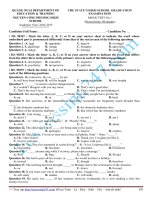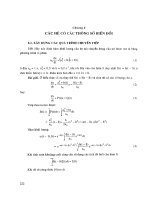Lecture Signal processing: Introduction - Nguyễn Công Phương
Bạn đang xem bản rút gọn của tài liệu. Xem và tải ngay bản đầy đủ của tài liệu tại đây (175.53 KB, 13 trang )
Nguyễn Công Phương
SIGNAL PROCESSING
Contents
I. Introduction
II. Discrete – Time Signals and Systems
III. The z – Transform
IV. Fourier Representation of Signals
V. Transform Analysis of LTI Systems
VI. Sampling of Continuous – Time Signals
VII.The Discrete Fourier Transform
VIII.Structures for Discrete – Time Systems
IX. Design of FIR Filters
X. Design of IIR Filters
XI. Random Signal Processing
sites.google.com/site/ncpdhbkhn
2
References
[1] D. Manolakis and V. Ingle. Applied Digital Signal
Processing. Cambride, 2011.
[2] J. G. Proakis and D. G. Manolakis. Digital Signal
Processing – Principles, Algorithms, and Applications.
Prentice – Hall, 1996.
[3] R. N. Bracewell. The Fourier Transform and its
Applications. McGraw-Hill, 2000.
[4] V. K. Madisetti, D. B. Williams. Digital Signal Processing
Handbook. CRC Press, 1999.
[5] A. V. Oppenheim, A. S. Willsky, and S. H. Nawab. Signals
and Systems. Prentice Hall, 1997.
[6] S. Stergiopoulos. Advanced Signal Processing Handbook.
CRC Press, 2001
[7] sites.google.com/site/ncpdhbkhn
sites.google.com/site/ncpdhbkhn
3
Introduction
To record, create, manipulate, transform, and transmit signals
sites.google.com/site/ncpdhbkhn
4
Introduction
1. Signals
2. Systems
3. Analog, Digital, and Mixed Signals
Processing
4. Applications of Digital Signal Processing
sites.google.com/site/ncpdhbkhn
5
Signals (1)
• Signal: a physical quantity varying as a
function (of time, space, etc.) and carrying
information
Index
L
R
i
+
C
v
e
–
+–
Current as
a function of time
M T W T F S
Closing value
of the stock exchange index
as a function of days
sites.google.com/site/ncpdhbkhn
Image as a function
of x–y coordinates
6
Signals (2)
Index
i (A)
t (s)
M T W T F S
s(t)
s[n]
Continuous – time signal
Discrete – time signal
Value of s(t) is defined for
every value of time t
Value of s(t) is defined
only at discrete time
sites.google.com/site/ncpdhbkhn
7
Signals (3)
i (A)
i (A)
T
t (s)
0
s(t)
5 6
1 2
3 4
n
7 8
s[n] = s(t ) t =nT = s(nT )
T : sampling period
1
f s = : sampling frequency
T
sites.google.com/site/ncpdhbkhn
8
Signals (4)
Deterministic signal
The future value is
predictable
Random signal
The future value is
unpredicatble
sites.google.com/site/ncpdhbkhn
9
Introduction
1. Signals
2. Systems
3. Analog, Digital, and Mixed Signals
Processing
4. Applications of Digital Signal Processing
sites.google.com/site/ncpdhbkhn
10
Systems
x (t )
Continuous – Time
System
Analog-to-Digital
Conversion (ADC)
x[n ]
Digital-to-Analog
Conversion (DAC)
Discrete – Time
System
sites.google.com/site/ncpdhbkhn
y (t )
y[ n ]
11
Analog, Digital, and Mixed
Signals Processing
Analog input
Sensor
Analog Pre-processing
ADC
DSP
DAC
Analog Post-processing
sites.google.com/site/ncpdhbkhn
Analog
output
12
Applications of Digital Signal
Processing
•
•
•
•
•
•
•
Key operations
Audio processing
Speech processing
Image & video processing
Telecommunications
Computer systems
Military
sites.google.com/site/ncpdhbkhn
13









